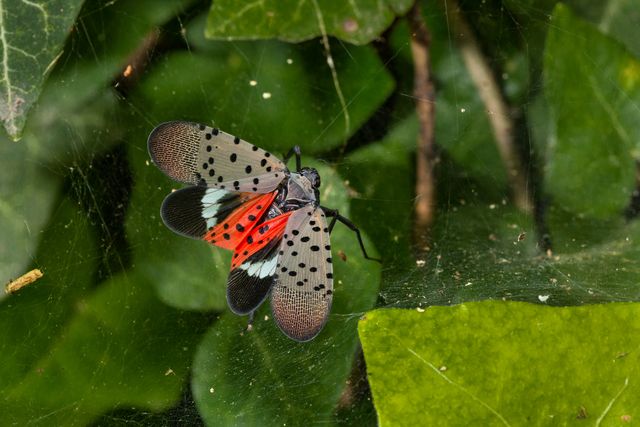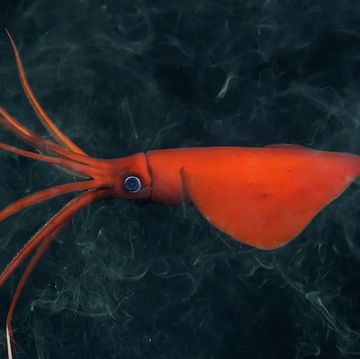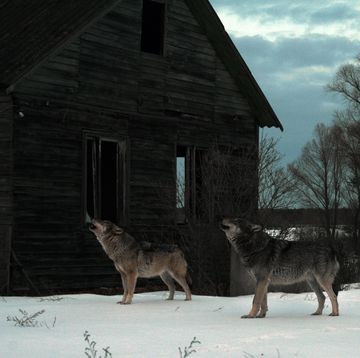- The invasive spotted lanternfly has invaded Pennsylvania and threatens to spread into neighboring states.
- Easily identifiable by its gray, spotted wings and bright red underwings, the insect could threaten billions of dollars worth of crops in Pennsylvania, such as apples, grapes, and hops.
- Report sightings of the dreaded insects to the Pennsylvania Department of Agriculture by calling this number: 1-888-4BADFLY. (For real.)
- Then, squash that sucker without remorse.
Desperate times call for desperate measures. The Pensylvania Department of Agriculture (PDA) is waging an all-out war on a tiny insect called the spotted lanternfly (Lycorma delicatula). Researchers at the Beneficial Insects Introduction Research Unit (BIIRU), a subdivision of the PADA, in Newark, Delaware, have come up with a plan to eradicate the invasive insect once and for all, using a curious weapon: wasps.
The lanternfly is not a fly, but instead, a type of insect called a planthopper. They're native to China, India, and Vietnam but were first discovered in the U.S. in Berks County, Pennsylvania. From there, they’ve spread across the state and slowly trickled into Delaware, New Jersey and Virginia.
(If you have a friend or family member who lives in Pennsylvania, you've probably been hearing them talk about nothing else besides these damn bugs for a year. Trust us: Popular Mechanics HQ is smack dab in the lanternfly epicenter. On behalf of our fellow Pennsylvanians, we're sorry.)
In the lanternflies’ wake, they’ve left a path of destruction. The insects feed on tree sap and excrete a sugary substance called honeydew when they eat. This sticky sap coats the surface of plants and encourages the growth of black sooty mold, which damages the plant or tree.
"One of the things that makes it so bad is that [the lanternfly] has a really broad host range," entomologist Heather Leach, of Penn State University, tells Popular Mechanics. "It feeds on over 70 different plant species."
Worst of all, spotted lanternflies are especially tough to kill. They swarm in vast numbers, have no natural predators, and lay gray egg masses of 30 to 50 eggs, which lie flat on tree trunks and look similar to lichen. Scientists fear they have the potential to devastate a number of valuable crops, such as apples, grapes for wine (!) and hops for beer (!!).
"We're seeing damage across a lot of different plant species," Leach says. They’re expected to cause billions of dollars in damages in Pennsylvania alone, according to the PDA, stoking fears that they may spread to states with robust agricultural industries. States like California and New York, which have prominent wine regions, are extremely worried about the lanternflies, Leach says.
But hope may be on the horizon.
Scientists believe the special wasp assassins, which are native to China and only hunt spotted lanternflies, could be a useful tool in eradicating the insect. These wasps ensure that lanternflies meet a gruesome end.
They lay eggs inside baby spotted lanternflies, which are called nymphs. When those eggs hatch, the hungry wasp larvae devour the nymphs from the inside out. Currently, the USDA is holding two species of wasp—one that feasts on the nymphs and another that feasts on egg masses—in quarantine facilities at the BIIRU lab in Newark and a lab in Massachusetts.
"These kinds of wasps are all around us," BIIRU research entomologist Kim Hoelmer tells Popular Mechanics. "There are hundreds of thousands of species, and most of them are so small that we don't even notice them."
He stresses that these wasps are different from yellow jackets, hornets, or paper wasps. They won't attack humans or pets, for example.
It’ll be a long road, though. BIIRU scientists don’t expect the wasps will be released for several years. There’s still a lot of work left to ensure that the wasps will be a helpful addition to the ecosystem. Hoelmer notes that they have to conduct experiments to test the wasps with other types of insects they may encounter in the ecosystem.
"We put the proposed candidate natural enemy (in this case a parasitic wasp) in an arena, often a tube or a petri dish, with a stages of the insect that we're testing," Hoelmer says.
That may sound brutal, but it's crucial to ensure that the wasps won't attack important noninvasive species in addition to the lanternflies.
But scientists like Leach remain positive that this plan will work.
Biological control "is a really common practice, and it's probably the thing that holds the most promise for us as far as long-term, sustainable control goes," says Leach. "That way, we're targeting spotted lanternflies and nothing else."
In the meantime, other efforts are underway to battle the bug. Insecticides are being used to help control the pest, but Leach says those insecticides are "broad-spectrum" insecticides and impact other, noninvasive insects like ladybugs and bees.
Efforts are also being made to contain the lanternfly's spread. Truckers crossing county and state lines are required to check their vehicles for signs of the hitchhiking insects. People who live in areas infested by spotted lanternflies have been asked to inspect their properties for the insects and destroy them.
It’s clear that the spotted lanternfly must be stopped at all costs. Needless to say, people are finding creative ways to kill the insect.
The PADA is urging people to report spotted lanternfly sightings by calling this very number: 1-888-4BADFLY. (Not 911.)
Jennifer Leman is a science journalist and senior features editor at Popular Mechanics, Runner's World, and Bicycling. A graduate of the Science Communication Program at UC Santa Cruz, her work has appeared in The Atlantic, Scientific American, Science News and Nature. Her favorite stories illuminate Earth's many wonders and hazards.














